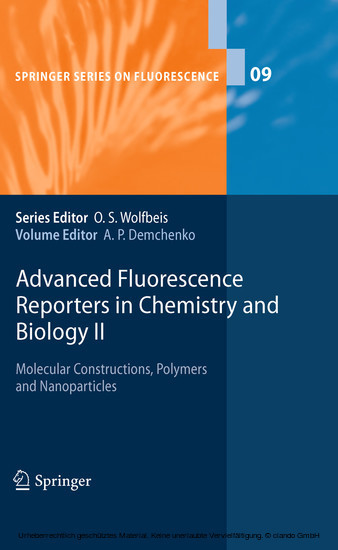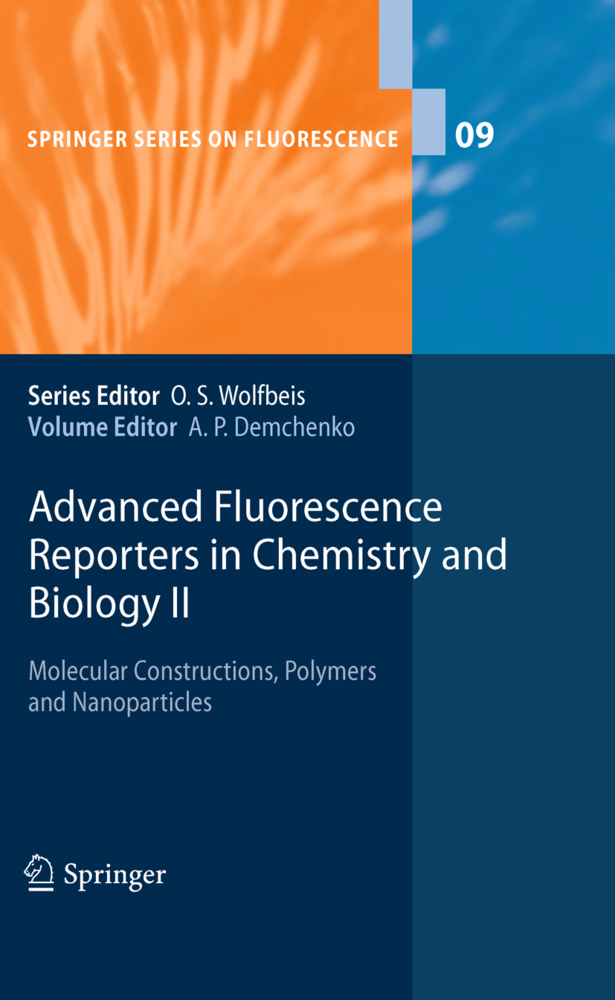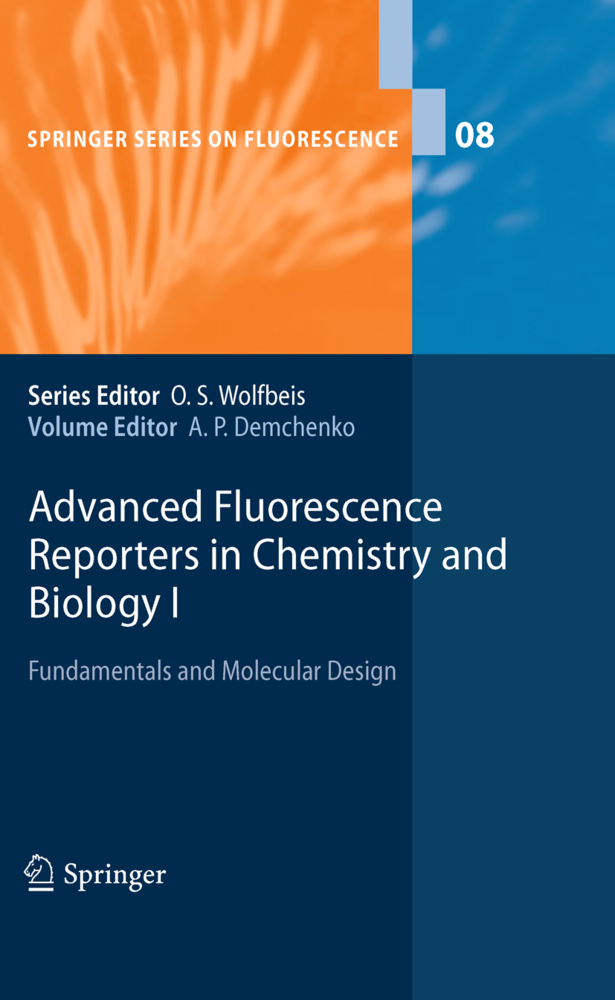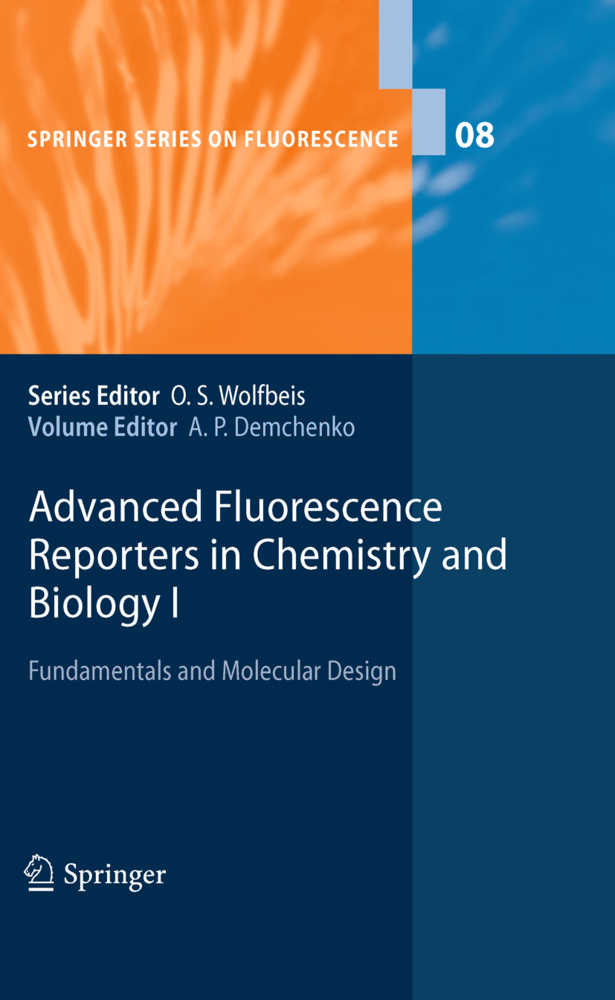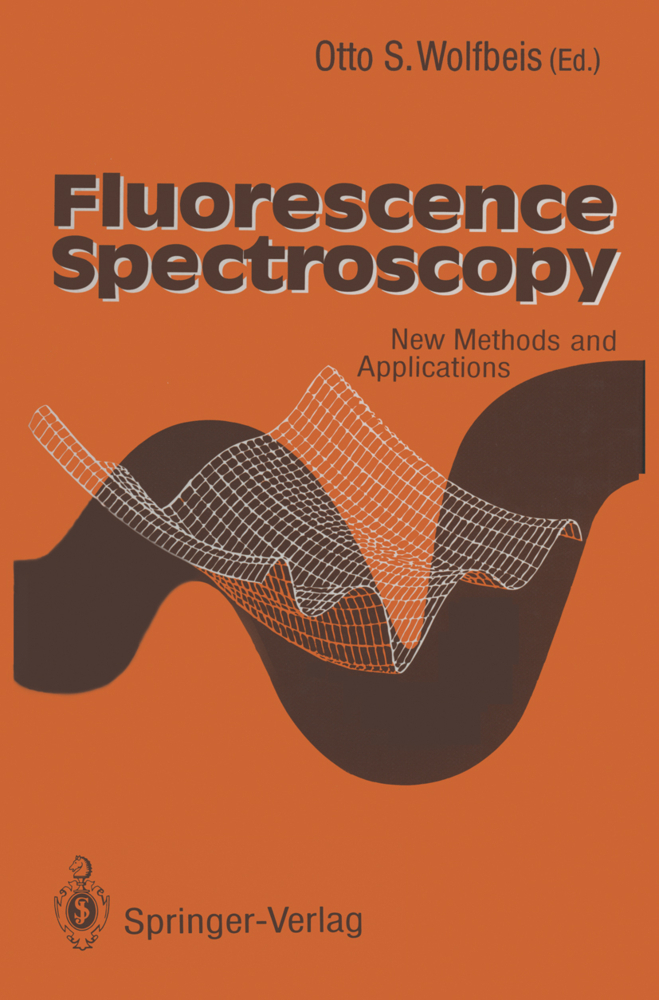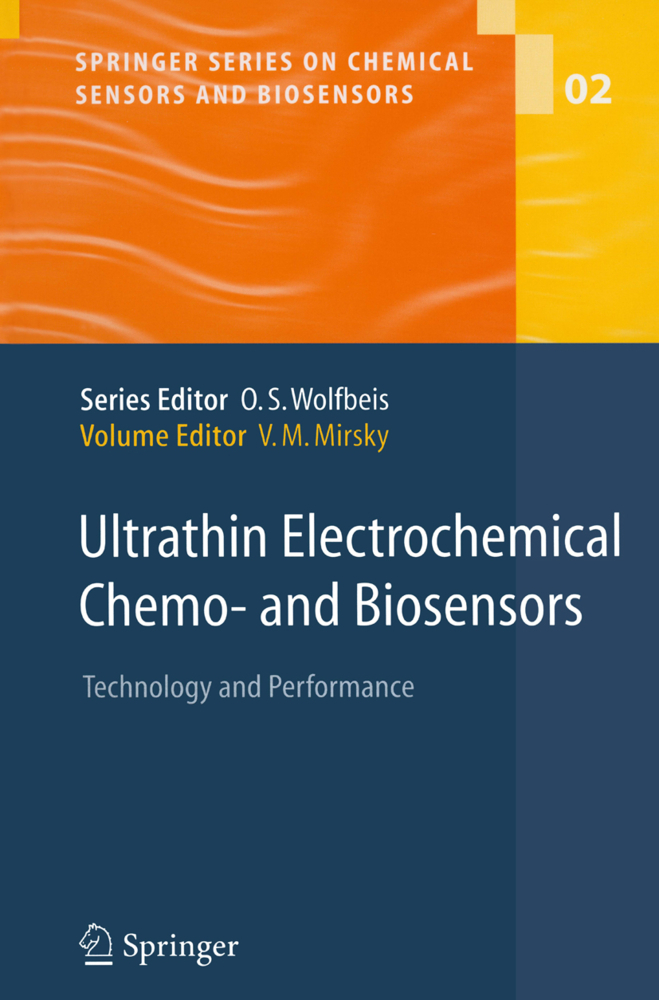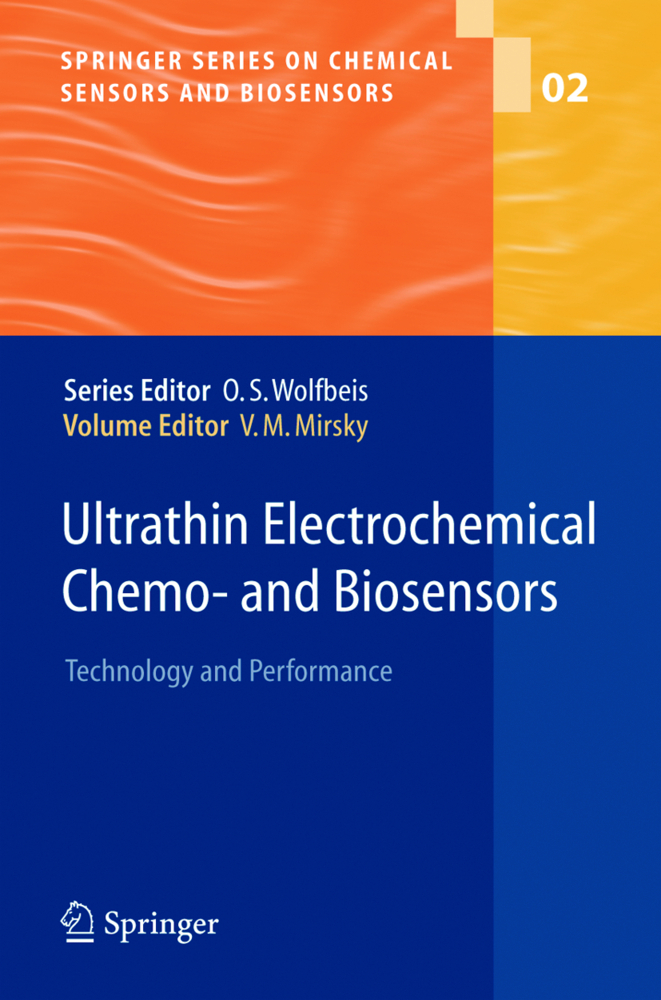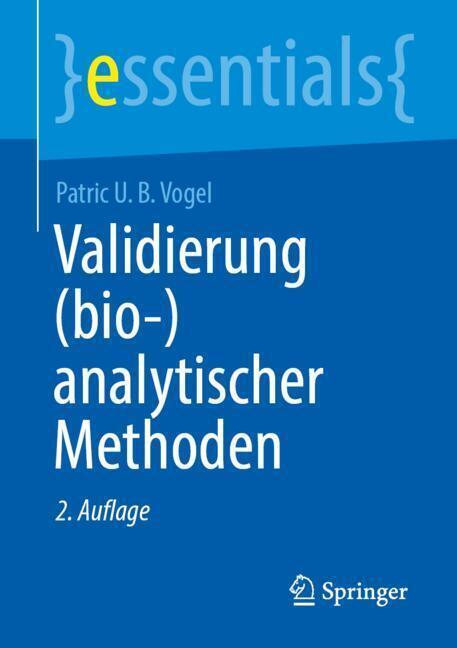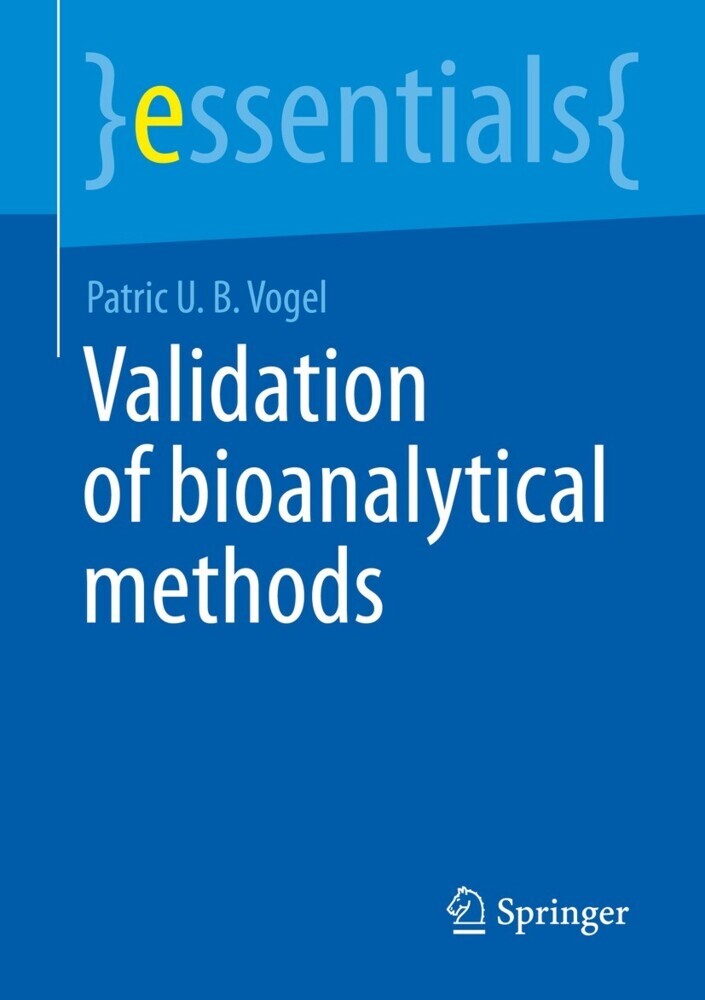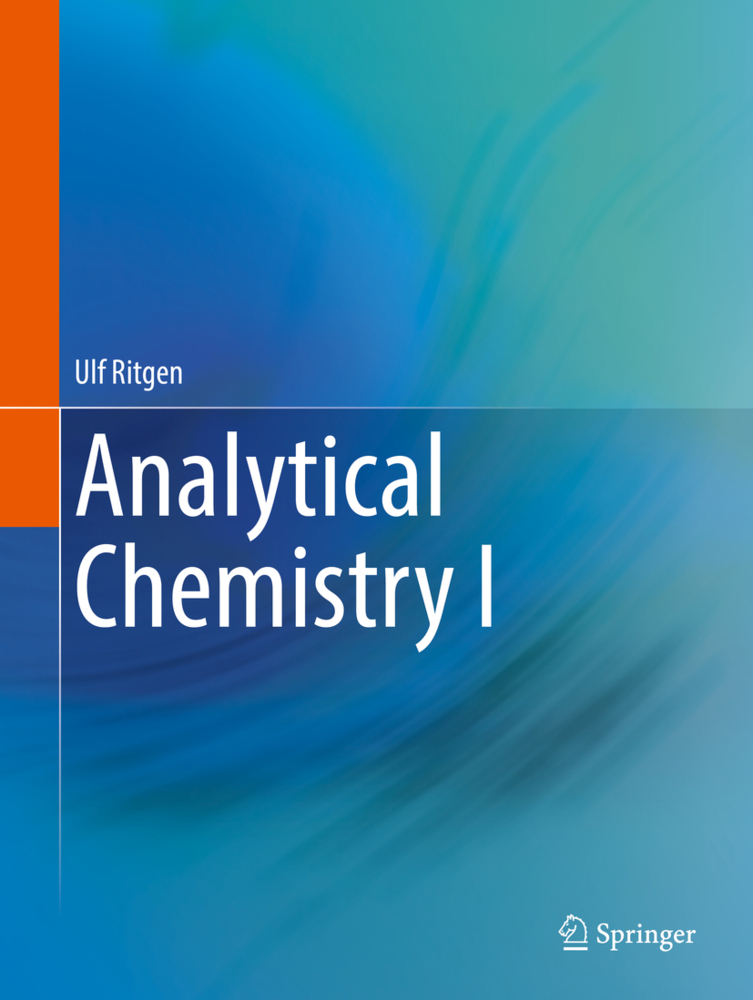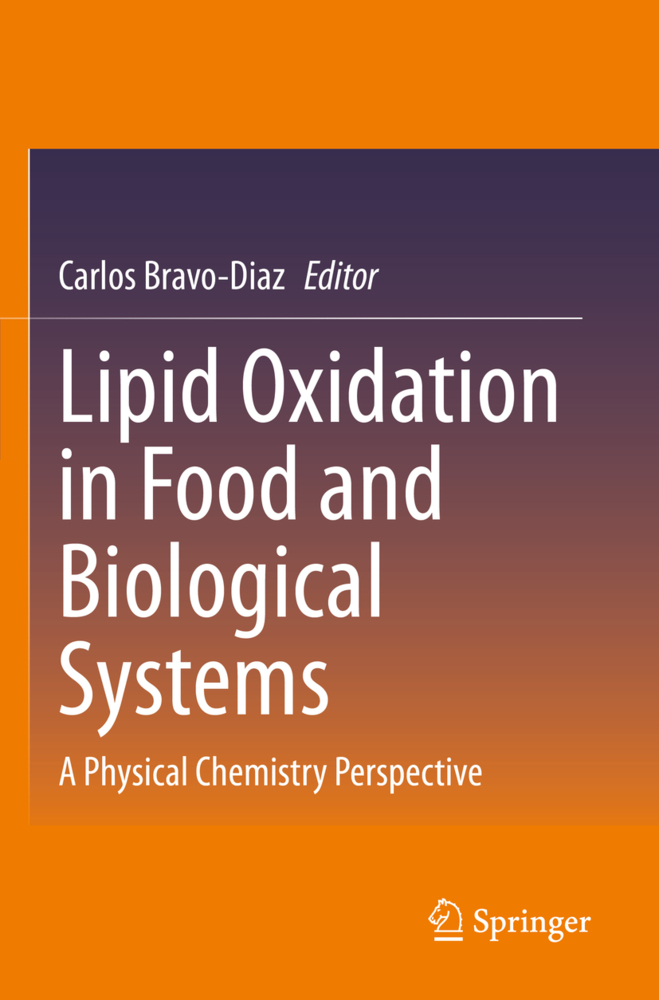Advanced Fluorescence Reporters in Chemistry and Biology II
Molecular Constructions, Polymers and Nanoparticles
This volume demonstrates the novel possibilities in sensing and imaging offered by the assembly of organic dyes into nanoparticles and nanocomposites and by the application of strongly fluorescent noble metal clusters and conjugated polymers. Its 14 chapters, written by top experts in this field, provide in-depth information on the coupling of organic dyes to different molecular and supramolecular structures, on their incorporation into polymeric nanoparticles and on the nanostructures that can be formed by some of the dyes. Bright and photostable several-atom clusters of gold and silver are examined. Finally, the revolutionary changes in sensing technologies attending the advent of conjugated polmyers and the advances in their application are discussed.
1;Advanced Fluorescence Reporters in Chemistry and Biology II;3 1.1;Molecular Constructions, Polymers and Nanoparticles;3 1.2;Series Editor;5 1.3;Aims and Scope;5 1.4;Preface;7 1.5;Contents;9 1.6;Part I: General Aspects ;11 1.6.1;Nanocrystals and Nanoparticles Versus Molecular Fluorescent Labels as Reporters for Bioanalysis and the Life Sciences: A Critical Comparison;12 1.6.1.1;1 Introduction;13 1.6.1.2;2 Properties of Molecular and Nanoparticular Labels and Reporters;15 1.6.1.2.1;2.1 Spectroscopic Properties;15 1.6.1.2.1.1;2.1.1 Luminescent Nanocrystals and Nanoparticles;16 1.6.1.2.1.2;2.1.2 Organic Dyes;21 1.6.1.2.1.3;2.1.3 Metal Ligand Complexes;22 1.6.1.2.1.4;2.1.4 Comparison of Chromophores;23 1.6.1.2.2;2.2 Solubility and Aggregation;26 1.6.1.2.3;2.3 Thermal and Photochemical Stability;27 1.6.1.2.4;2.4 Cyto- and Nanotoxicity;28 1.6.1.3;3 Application of Molecular and Nanoparticulate Fluorophores;30 1.6.1.3.1;3.1 Coupling Chromophores to Biomolecules;30 1.6.1.3.2;3.2 Extra- and Intracellular Targeting of Biomolecules;32 1.6.1.3.3;3.3 Interactions Between Chromophores and their Microenvironment;33 1.6.1.3.4;3.4 Exploitation of Förster Resonance Energy Transfer;35 1.6.1.3.5;3.5 Multiplexing Detection Schemes;36 1.6.1.3.5.1;3.5.1 Spectral Multiplexing;36 1.6.1.3.5.2;3.5.2 Lifetime Multiplexing;37 1.6.1.3.6;3.6 Strategies for Signal Amplification;38 1.6.1.3.7;3.7 Reproducibility, Quality Assurance and Limitations;38 1.6.1.4;4 Applications of Nanoparticles: State-of-the-Art and Future Trends;40 1.6.1.5;5 Conclusions;42 1.6.1.6;References;42 1.6.2;Optimization of the Coupling of Target Recognition and Signal Generation;50 1.6.2.1;1 Introduction;51 1.6.2.2;2 Channels of Communication between Binding Site and Fluorophore;53 1.6.2.2.1;2.1 pi-Conjugated Binding Site and Fluorophore;55 1.6.2.2.2;2.2 Spacer-Separated Binding Site and Fluorophore;59 1.6.2.2.2.1;2.2.1 Single Binding Site-Single Fluorophore Architectures;59 1.6.2.2.2.2;2.2.2 Single Binding Site-Double or Multi Fluorophore Architectures;63 1.6.2.3;3 Strategies of Signal Optimization in Fluorescent Probes;65 1.6.2.3.1;3.1 Combinatorial Synthesis of Functional Fluorophores;66 1.6.2.3.2;3.2 Design of Communication Channels for ``Light-Up´´ Probes;66 1.6.2.3.2.1;3.2.1 For Metal Cations;67 1.6.2.3.2.2;3.2.2 For Anions;70 1.6.2.4;4 Strategies of Signal Amplification;74 1.6.2.4.1;4.1 Chemical Reactions;74 1.6.2.4.1.1;4.1.1 Transformation of a Leuko Dye into a Fluorophore (Chemodosimeter);75 1.6.2.4.1.2;4.1.2 Catalytic Production of Fluorophores;78 1.6.2.4.1.3;4.1.3 Systems Based on Chemi- and Bioluminescence;80 1.6.2.4.2;4.2 Displacement of Fluorophores from Binding Sites;83 1.6.2.4.3;4.3 Increasing the Number of Fluorophores per Binding Site;86 1.6.2.4.4;4.4 Involving Fluorophore Communication;90 1.6.2.4.4.1;4.4.1 In Conjugated Polymers;91 1.6.2.4.4.2;4.4.2 In Nano- and Microparticles;92 1.6.2.4.4.3;4.4.3 In Dendrimers;93 1.6.2.4.5;4.5 Resonance Energy Transfer;95 1.6.2.4.5.1;4.5.1 Förster/Fluorescence Resonance Energy Transfer ;97 1.6.2.4.5.2;4.5.2 Bioluminescence Resonance Energy Transfer ;101 1.6.2.5;5 Conclusion;101 1.6.2.6;6 Further Reading;104 1.6.2.7;References;105 1.6.3;Collective Effects Influencing Fluorescence Emission;116 1.6.3.1;1 Introduction;117 1.6.3.2;2 Spectroscopy of Intermolecular Interactions;118 1.6.3.2.1;2.1 Universal Intermolecular Interactions;118 1.6.3.2.2;2.2 Hydrogen Bonding in the Ground and Excited States;120 1.6.3.2.3;2.3 Excimers and Exciplexes;121 1.6.3.3;3 Resonance Interactions between Fluorophores;122 1.6.3.3.1;3.1 Electron Exchange Interactions;122 1.6.3.3.2;3.2 Förster Resonance Energy Transfer;122 1.6.3.4;4 Site-Selective Red-Edge Effects;123 1.6.3.5;5 Collective Effects Observed with Organic Dyes;125 1.6.3.5.1;5.1 Superquenching, Concentrational Quenching, and Directed Homo-FRET;126 1.6.3.5.2;5.2 Wavelength Converting;127 1.6.3.5.3;5.3 Light-Harvesting (Antenna) Effects;129 1.6.3.5.4;5.4 Red-Edge Effects in Energy Transfer;130 1.6.3.6;6 C
Demchenko, Alexander P.
| ISBN | 9783642047015 |
|---|---|
| Artikelnummer | 9783642047015 |
| Medientyp | E-Book - PDF |
| Auflage | 2. Aufl. |
| Copyrightjahr | 2010 |
| Verlag | Springer-Verlag |
| Umfang | 462 Seiten |
| Sprache | Englisch |
| Kopierschutz | Digitales Wasserzeichen |

